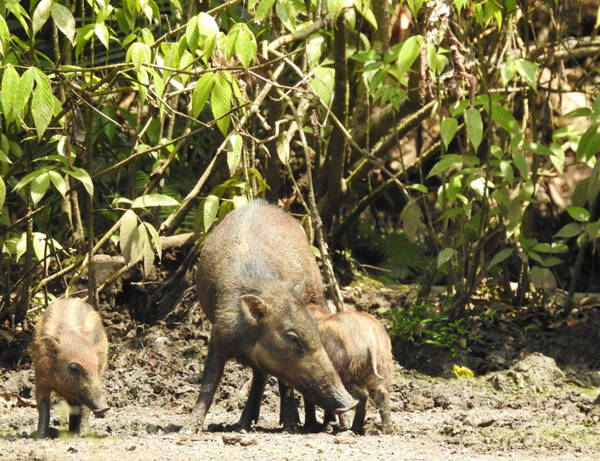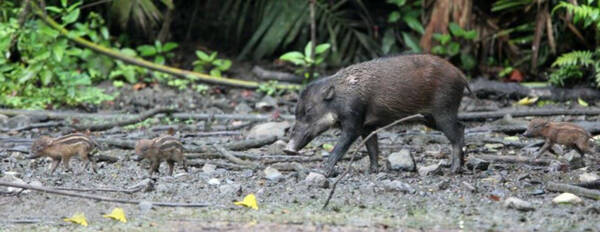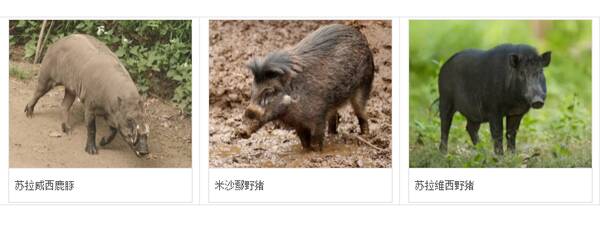Sus celebensis
IUCN
LCBasic Information
Scientific classification
- name:Sus celebensis
- Scientific Name:Sus celebensis,Sulawesi Warty Pig,Celebes wild boar
- Outline:Ungulata
- Family:Artiodactyla Suidae Sus
Vital signs
- length:80-130cm
- Weight:40-70kg
- lifetime:10-20years
Feature
Piglets are born with five dark brown and six lighter parallel stripes along the length of their bodies.
Distribution and Habitat
The Sulawesi wild boar is found on the Indonesian island of Sulawesi, where it still exists in central, eastern and southeastern Sulawesi. It is rare in southern and northeastern Sulawesi and may be extinct on nearby Seraya Island. It may also survive on the neighboring islands of Buton, Muna, Kabeana, Peleng, Lembeh and some of the Togian Islands. This species has also been domesticated and widely transported to other islands, where it often hybridizes with the Eurasian wild boar, giving rise to various introduced domestic and wild pig populations in Indonesia. Various domestic and wild pig populations have been introduced on the islands of Flores, Timor, Simeuleu, Seram, Buru and Nias. Domesticated Sulawesi wild boars can be seen on the islands of Roti and Sawu.
The Sulawesi wild boar inhabits rainforests, swamps, open grasslands and agricultural areas across the Indonesian archipelago. It is also found in mossy forests from sea level to about 2,300 meters above sea level, but pre
Appearance
Male Sulawesi wild boars are larger than females, with a head-body length of 80-130 cm, a shoulder height of 60-70 cm, an average shoulder width of 60 cm, and a weight of 40-70 kg. They have a rounded back with a slightly convex shape, relatively short legs, and a very long tufted tail. The fur is usually gray-black or black, sometimes mixed with red or brown on the sides of the body, fading to creamy white on the ventral side with age. There is a distinctive tuft of hair on the top of the head or forehead, and sometimes some short black hairs on the back of the neck, extending into a black dorsal stripe. The short face is usually dark, with a prominent yellow hair that surrounds the nose in front of the eyes, and a tuft of light hair on each cheek. Both sexes have three pairs of facial warts, but they are more obvious in males. As they age, all the warts increase in size until the pair of facial warts reach their largest size until they are at least 8 years old. The ears are relativel
Details
Sulawesi Warty Pig (scientific name: Sus celebensis) has three subspecies.

The Sulawesi wild boar has a home range of 500-1000 hectares for females and 1000-2000 hectares for males. As mammals, they communicate using some combination of vision, hearing, touch, and emitted chemical scents. They are social. The basic social unit is the family group, with 2-3 family groups forming larger groups. Males are primarily solitary, except during breeding. Physical aggression, including leaning, pushing, and threatening with an open mouth, has been reported.
The Sulawesi wild boar is primarily a diurnal forager, with most of its feeding activity occurring during the day, concentrated in the early morning and evening. Other members of the genus thus wander the same feeding areas over a long season as different food sources become available. There is no information on the specific distances covered by the Sulawesi wild boar. Other members of the genus can build crude shelters or nests out of weeds. This apparently helps them stay quiet. All members of the genus are thought to enjoy mud baths. Omnivorous. Feeds mainly on plant roots, fallen fruits, young leaves, and shoots, but also consumes invertebrates, small vertebrates, and carrion.
Sulawesi wild boars usually live in groups of 1-6 animals, but the social composition of these groups is not fully understood. In one group (Tanjung Peropa Wildlife Reserve), the sex ratio of adult Sulawesi wild boars was 1:1.25 (n = 25), and group size varied between 2-9, with an average of 5 (n = 16). Small groups usually consisted of 1-3 pups, 1-2 subadults, and 1-3 adults.

Reproduction of Sulawesi wild boars can occur at any time of the year, but peaks in February, with most piglets born in April-May. Females build nests, made of grass, leaves and branches of plants, piled in shallow depressions up to two meters deep. Unlike most ungulates, members of the Sulawesi wild boar bring protection to their offspring in their nests, which they keep for a while. The estrus cycle of sows is about 21 days, during which females are only receptive to sex for 2-3 days. The gestation period is 100-140 days. The litter size is estimated to be 2-8, with an average of 5, and piglets weigh 500-1,500 grams at birth and are weaned within 3-4 months. Most females begin to reproduce at about 18 months of age. Males, although capable of reproducing at a younger age, usually wait until around 5 years old to associate with a mate. Human activity has greatly increased the distribution of the Sulawesi wild boar, as these wild boars were introduced to the islands of Halmahera, Flores, and Timor when they became part of the local menu. On Roti, they are kept as domestic animals, but may have hybridized with the Eurasian wild boar. In the Moluccas, Aru Islands, and New Guinea, they are called Papua Pigs. Piglets of this species are reportedly actually fed by indigenous women with their own breast milk. These pigs are half domesticated and half wild, and voluntarily return to settlements at night after receiving different drum signals from their respective owners.
The Sulawesi Babirusa is the only wild pig of the same species as the Sulawesi Wild Boar. Unlike the Sulawesi Wild Boar, the Sulawesi Babirusa has only sparse hair on its body; their faces are long and narrow, and the male Sulawesi Babirusa has distinctive tusks on the top of its snout. The Visayan Wild Boar has a similar pale muzzle band, but tends to be pale grey and lacks prominent warts. Males are much larger than the Sulawesi Wild Boar.

The density of Sulawesi wild boar ranged from 0.4–2.0 animals/km2 in one protected area in the northern peninsula to 1.8–19.8 and 5.1–14.5 animals/km2 in two protected areas in the southeastern peninsula, with the study finding that the species was even more dense in the protected areas, with 23.5 animals/km2 in lowland forests. This major difference in density is due to changes in hunting pressure related to religion, with higher densities in Muslim-dominated areas, where people do not eat pigs, than in Christian-dominated areas. However, since inter-island trade is common, it is unclear to what extent Muslim-dominated areas serve as suppliers to Christians. Also, in the predominantly Muslim southeastern peninsula, where the Sulawesi wild boar subspecies is apparently extinct, it is clear that religious affinity was not sufficient to prevent local extinction of the species.
Apart from the reticulated python, there are no other significant natural predators on Sulawesi and its offshore islands. Changes in land use and hunting pressure have led to a reduction in its previous range. The Sulawesi wild boar is not threatened throughout most of its range. However, large-scale deforestation and conversion of land to agricultural use, combined with population growth and immigration, have led to a significant reduction in its range in some locations. Furthermore, resources are insufficient to implement hunting control, and there are reports that subsistence and/or organized commercial hunting continues even in designated protected areas and national parks. The high volume of trade in this species raises concerns about the sustainability of current harvest rates. The completion of the Trans-Sulawesi Highway is likely to increase imports of wildlife into and from North Sulawesi from other parts of the island. Data were collected from market surveys in Northeast Sulawesi and at roadblocks on the Trans-Sulawesi Highway. In the study it was noted that “the volume of trade in the Sulawesi pig is alarmingly large”. The expansion of human settlements also poses an increased threat of genetic contamination and/or disease to wild boar populations. Future threats would include loss of the species’ high genetic diversity through the reduction of small herds.
The Sulawesi wild boar is of particular interest because it is the only pig species other than the Eurasian wild boar that has been domesticated and has been widely transported outside its native range by human agents. Available evidence suggests that it is still kept as a domesticated species in some areas, but its commercial importance and future potential as a genetic resource is virtually unknown.
Listed in the IUCN Red List of Threatened Species in 2008 ver 3.1 - Near Threatened (NT).
Protect wild animals and eliminate game.
Maintaining ecological balance is everyone's responsibility!








